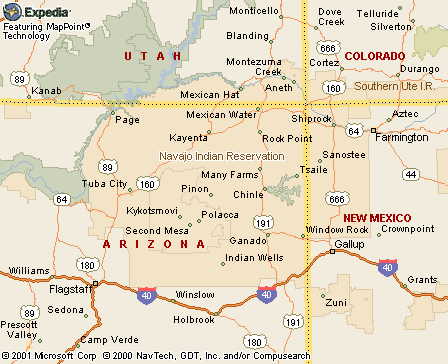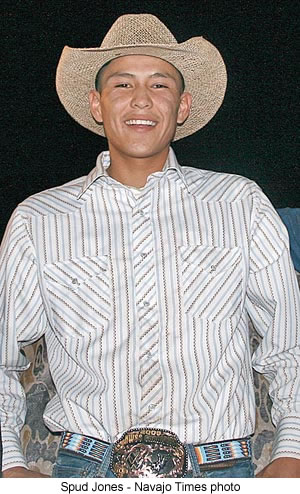 |
Canku Ota
|
 |
|
(Many Paths)
|
||
|
An Online Newsletter
Celebrating Native America
|
||
|
January 1, 2009 - Volume
7 Number 1
|
||
|
|
||
|
No Reservations
Bull Rider Spud Jones' Drive - and Driving - Have Led Him a Long Way From Navajo Nation |
||
|
by Sam Eifling - ESPN.com
|
||
|
credits: photo courtesy
of The Navajo Times
|
|
Always has. In high school, when he broke his leg riding a bronc? He tried healing for three months and then cut the cast off himself. Couldn't stay off horses and bulls. Now, as a pro, he rides to earn and he rides out of sheer wanderlust. Maybe it comes from driving around the West as a small boy with his father, J.W. Jones, a sheet metal worker now, but from 1987 to 1994 a Professional Rodeo Cowboys Association cardholder, a bull rider like Spud is today. His father never reached the height that the son has enjoyed last week. By qualifying for his first Wrangler National Finals Rodeo berth, the 20-year-old Jones became perhaps the first Navajo to ride bulls in the world's biggest rodeo. To reach it - barely - he hit 70 PRCA rodeos, traveling, for the first time, primarily on his own. It was a long year, and when he came home to Twin Lakes, N.M., for three or four days at a spell, it was just to rest and eat his mom's cooking and swap out dirty clothes for clean. "I can't stay home," Jones says. "On the reservation, everything slows down. I'd be walking outdoors, 'Damn. I got to go somewhere.' "I love driving," he continues. "I miss traveling real hard right now." Not that Vegas or the WNFR haven't exceeded his expectations. Through nine rounds, Jones has covered four of his bulls and earned more than $20,000 on his way to sitting sixth in the average. And he's easy to spot. He's the jangly, 6-foot-1, 150-pounder who's always grinning after his rides. Jones, 20, grew up 90 miles from the Four Corners on the Navajo Reservation. He's seen his name in lights and on handmade signs in the stands, heard it on the public address. And still - he misses driving. For a young man who grew up in a no-stoplight town 90 miles southeast of the Four Corners, a place so small his parents drive 15 miles to pick up their mail, the tug of the road and rodeoing is always strong. Then again, if this is where it leads, it's no wonder Jones rodeos compulsively. The Navajo love rodeo the way few people do. They play basketball in the winter, Jones says, but "when it hits spring and summer, it's just rodeo all the way around." Anyone trying to find one need only pick up an issue of the local newspapers and flip to the ads in the sports section. Through much of the WNFR, a radio reporter relayed standings and scores back to the Navajo Nation - in Navajo. No wonder: It was a big year in Vegas for Native Americans. With Jones and team roper Derrick Begay, of Seba Dalkai, Ariz., both qualifying, the Navajo Nation, a sprawling reservation of fewer than 200,000 people, has two WNFR participants for what is believed to be the first time. "I don't really know the reason we love rodeo so much," Begay says. "There really ain't much to do out there on the reservation except ride horses and raise cattle, raise sheep. "I always wanted to come here, but I never thought I would," the roper continues. "Shoot. Now I'm here. I don't know how I did it. It was one of those impossible dreams." Jones can barely venture a guess as to what he'd be doing if not for rodeo. "Maybe working cattle?" he says. "Maybe going to school somewhere? I don't even know. I don't know where I'd be without bull riding and rodeo." He did try school for a while. He graduated from high school at 17, and enrolled in Navajo Technical College for seven months. When he turned 18, the minimum age to receive a PRCA card, he was out of there. "It's what he likes to do," says Jones' mom, Michaelene. "He just wants to ride is all he does. He never looked for a job or anything." With his father on the road so much when he was a boy, it was she who took Jones to his first rodeo at age three, where he began wooly riding (that's riding sheep, same as mutton bustin'). As he grew, she watched him climb onto his dad's bucking barrel day, night, rain, snow, scorching desert heat. "He doesn't stay inside much," she says. The family does travel with him sometimes, as when he won the Indian International Finals Rodeo in Prince Albert, Saskatchewan, last year. She brought along her electric skillet, potatoes, tortillas and green chili. The further north you get, Jones has learned, the harder it is to find hot peppers. But the young man was largely on his own this year, burning gas in his little S-10 pickup, calling home with the good news (winning Denver was his highlight), tiptoeing around his injuries (his parents know he hurt his chest or rib or lung or something, but can't tell you exactly what) and subsisting often on one meal a day, usually at an IHOP ("eat breakfast," he says, "and it will last you all day"). Or if he did well at an event, sitting alone in a Mexican restaurant afterwards. Jones has won a considerable amount of money during the 2008 WNFR. His mom does make some of his lodging arrangements on those times when he has to fly, which he dislikes given that he's too young to rent a car. On one particularly road-weary stretch he had to fly from Boise to Huron, S.D. She typically checks with a hotel to see whether it offers shuttle service. This time, however, the ground transport fell through, and rather than call a cab, Jones hitchhiked to the event. She just remembers him calling as he walked along the highway. "That was so bad for him," says his mom. "I didn't want him to notice that I was crying on the phone." Jones, always upbeat, told her not to worry, because he figured someone would stop for him. Jones was ready to drive the 1,400-odd miles to Indianapolis for the Dodge Xtreme Bulls Tour Finale in October. Instead, his parents booked tickets for him and his father before he could protest. Scoring on one of his bulls in Indianapolis made Jones the last man in the door at the WNFR, just $456 ahead of the 16th place man in the standings. "He won only $600," his father says. "But it brought him here." After Saturday night's final round, it will be back on the road for Jones. He's actually looking forward to going home, to rest up for a few weeks, before next season. But first he's going to take a detour from Vegas to California. See, on one of his trips up and down the coast, he has taken up surfing, so he wants to catch some waves before heading back to the desert. Less than a month 'til Denver, you know. "One thing about being hurt is, you've got something to look forward to," he said, "and that's getting healthy." |
 Navajo Indian Reservation map |
www.expedia.com |
|
|
||
|
|
||
| Canku Ota is a free Newsletter celebrating Native America, its traditions and accomplishments . We do not provide subscriber or visitor names to anyone. Some articles presented in Canku Ota may contain copyright material. We have received appropriate permissions for republishing any articles. Material appearing here is distributed without profit or monetary gain to those who have expressed an interest. This is in accordance with Title 17 U.S.C. Section 107. | ||
|
Canku Ota is a copyright ©
2000, 2001, 2002, 2003, 2004, 2005, 2006, 2007, 2008, 2009 of Vicki
Barry and Paul Barry.
|
||
 |
 |
|
|
The "Canku
Ota - A Newsletter Celebrating Native America" web site and
its design is the
|
||
|
Copyright ©
1999, 2000, 2001, 2002, 2003, 2004, 2005,
2006, 2007, 2008 of Paul C.
Barry.
|
||
|
All Rights Reserved.
|
||
 Spud
Jones just goes.
Spud
Jones just goes.